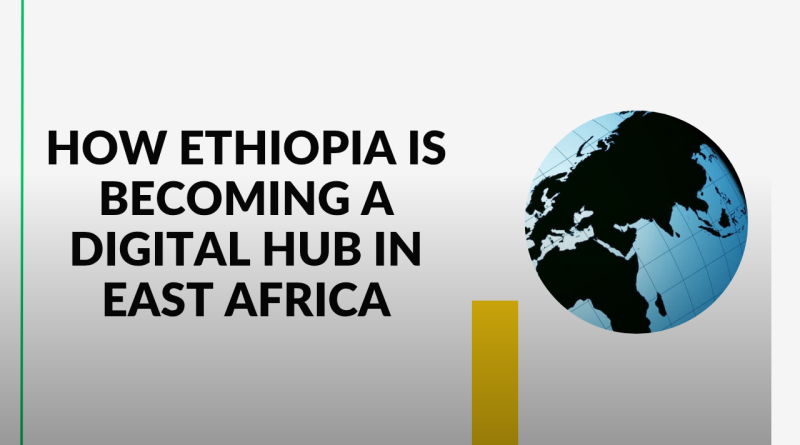How Ethiopia Is Becoming a Digital Hub in East Africa
Ethiopia is rapidly transforming into a leading digital hub in East Africa. Thanks to bold government initiatives like Digital Ethiopia 2025, national digital programs, skyrocketing mobile penetration, and investments in infrastructure, the country is poised for a new era of economic and technological growth .
1. Government Push: Digital Ethiopia 2025 Strategy
Launched in 2020 and reinforced by updated policies in 2023–24, Digital Ethiopia 2025 focuses on:
Improving broadband access
Developing digital public infrastructure (like national IDs)
Promoting public-private partnerships
Encouraging cybersecurity and data protection
Impact highlights:
Over 130 government services digitized across 25 agencies
Nationwide fiber expansion covering more than 23,000 km
Data protection framework (Proclamation No. 1321/2024) now in place
These reforms are gradually dismantling old systems, steering Ethiopia toward e-governance, e-commerce, and a digitally connected public service ecosystem.
2. Powering the Digital Backbone: Infrastructure & Data Centers
Digital growth demands robust physical infrastructure. Investments are transforming Ethiopia’s connectivity and data capacity.
Fiber-Optic & Network Expansion
Efforts from Ethio Telecom and Safaricom Ethiopia have extended 4G to dozens of cities, reaching nearly 35% population coverage . Fiber-optic expansions promise better internet speeds, more stable connections, and future 5G readiness.
Data Centers: Hosting Domestic Data
In April 2025, the IFC committed $100 million to Raxio Group’s data center builds in Ethiopia, adding to Tier‑III capacity . Local data centers will reduce latency, improve cloud services, and boost cybersecurity. This local infrastructure attracts international players like Amazon Web Services, Microsoft Azure, and Huawei.
3. Digital Identity: Introducing the “Fayda ID”
The Fayda ID system gives every Ethiopian a 12-digit biometrically verified national ID . With over 9 million registered so far, the program aims to reach 90 million residents.
Benefits include:
Seamless digital onboarding for bank accounts and e-payment apps
Secure e-KYC processes streamlined across sectors
Improved fraud control and data-backed governance decisions
The initiative is part of a broader push for digital shared infrastructure and public service modernization.
4. Fintech Boom: Mobile Money & E-Payments
Ethiopia’s fintech space is booming, driven by mobile money services and digital payments.
Telebirr by Ethio Telecom
Launched in 2021, Telebirr has attracted over 51 million users, processing trillions of Birr in transactions—including airtime, utility bills, and merchant payments .
Safaricom’s M-PESA
Launched in August 2023, M‑PESA hit over 3.1 million users by early 2024 . It bolsters financial inclusion, offers cross-border payment facilities, and supports Ethiopia’s cash-lite economy.
Safety nets like these make Ethiopia’s financial sector more inclusive, transparent, and efficient.
5. Digital Skills & Workforce Development
Digital adoption depends on skilled professionals. Ethiopia’s government is actively responding:
5 Million Ethio‑Coders initiative: over 688,000 trainees so far
National AI policy (June 2024) positions Ethiopia for innovation in AI, ML, and computer vision
Increasing efforts in workforce training and startup support via Ethiopia’s Digital Foundation Project and digital literacy programs
These efforts ensure that Ethiopians can build and maintain the country’s digital future.
6. Economic Effects: EdTech, e-Governance & E-Commerce
Education & e-Learning
Live online classes, digital research resources, and remote education are becoming accessible beyond urban centers. High-speed mobile internet and Uzbek IDs make digital literacy more widespread .
e-Governance
4936-0Linking digital IDs with government services and bank systems enables smoother public transactions—example: paying fees or taxes via Telebirr .
e-Commerce & Digital Business
Although still early, digital platforms for local goods are emerging. Liberalizing banking, allowing foreign fintech, and enabling electronic transactions are steps toward a robust online marketplace .
7. Challenges to Address
Despite rapid progress, the road ahead has key challenges:
Challenges Description
Urban–Rural Gap 76% of rural population still offline; major push needed for inclusive access
Electricity & Infrastructure Frequent outages in rural areas slow down digital adoption
Skill & Literacy Gap Many lack usage skills; digital literacy initiatives are imperfect at scale
Regulatory Complexity Red tape and unstable policies hinder business formation and foreign investment
Closing these gaps will determine whether Ethiopia can sustain its digital momentum.
8. Ethiopia in the East Africa & Global Context
Ethiopia’s digital achievements position it competitively in East Africa:
Largest telecom market in East Africa (~87 million mobile subscriptions)
Listing of Ethio Telecom in the Ethiopian Securities Exchange (ESX) supports digital age financing
Major infrastructure linkups (like Kenya–Ethiopia power/data projects) enhance regional integration
By 2028, Ethiopia’s digital economy could add $10.8 billion to GDP — a 39% uplift .
9. Looking Ahead: What to Expect by 2028
5G & Fiber Expansion: Extended to major and secondary cities
Data Centers: Continued growth with global cloud providers onshore
Fintech Maturation: Full interoperability, merchant adoption, remittances
AI & Automation: Growth of AI startups, especially in agriculture, health
e-Governance: More services available online seamlessly via Fayda-ID
Digital SMEs Growth: Products go online; talent creation continues
Cross-Border Partnerships: Digital corridors with Kenya, East Africa
This aligns perfectly with Ethiopia’s economic liberalization and global technology integration.
Conclusion: Ethiopia’s Digital Transformation Journey
From a government-led digital policy to vast infrastructure investments, growing mobile users, data centers, fintech, digital ID systems, and a budding startup base, Ethiopia is well on its way to becoming a major digital hub in East Africa.
Still, to make the vision inclusive and sustainable, the country must:
- Expand rural broadband (4G/5G + electricity)
- Boost digital skills countrywide
- Simplify regulations for foreign investors and entrepreneurs
- Continue strengthening data security and regulatory frameworks
Ethiopia’s digital transformation is no longer aspirational—it’s underway. If policymakers, investors, and the private sector keep working together, the country is set to emerge as a regional digital leader by 2028.
